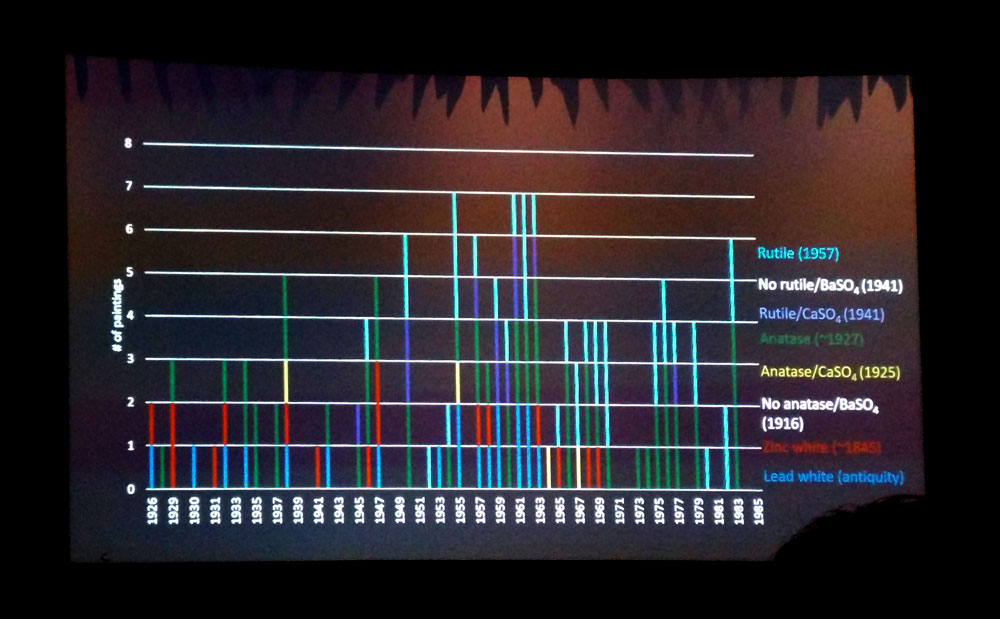"The Dating Game: A New Diagnostic Marker for Dating and Provenancing of Titanium White Pigments."
Speaker: Dr. Corina Rogge; Co-author: Julie Arslanoglu
https://aics47thannualmeeting2019.sched.com/event/IuhZ
During the 20th century, titanium white became the most popularly used white-colored artists' oil paint. This pigment is commonly found in works by artists such as Franz Kline, Hans Hofmann, Barnett Newman, Andy Warhol, Robert Rauschenberg, and Jackson Pollock. Over its decades of use, commercially-produced titanium white paint changed in composition as a result of innovations in pigment manufacturing technology. Paintings conservators today have likely heard the terms "anatase" and "rutile" which refer to two forms of the titanium dioxide pigment. Anatase was first introduced in 1916 and rutile in 1957. In addition to these keystone dates, Dr. Corina Rogge provided a detailed timeline for each variation with their corresponding co-precipitants. This timeline provides more precise benchmarks to compare and date titanium dioxide pigment samples.
|
Anatase
|
Rutile
|
|
1916: TiO2/BaSO4 composite pigment introduced
1925: TiO2/CaSO4 composite pigment introduced
1928: pure TiO2 widely available
1940s: TiO2/BaSO4 and TiO2/CaSO4 composite pigments phased out
|
1941: TiO2/BaSO4 and TiO2/CaSO4 composite pigments introduced
1940s-50s: TiO2/BaSO4 composite phased out
1957: pure TiO2 widely available
1970s: TiO2/CaSO4 composite phased out
|
It is important to note that titanium white paint cannot be dated simply by acknowledging the presence of barium or calcium sulfate. Paint manufacturers commonly added fillers containing sulfates to their media; as a result, co-detection of these compounds does not provide enough information to distinguish between the co-precipitated pigments and manually mixed pigments.
The exciting discovery that changed all this occurred while Rogge was analyzing titanium white paint samples at the Museum of Fine Arts, Houston (MFAH). She noticed a region of the Raman spectrum showed luminescence peaks distinct from the bands characteristic to anatase, rutile and sulfate. Since then, this titanium dioxide Raman research project has expanded to include other case studies from MFAH, the Menil Collection, and the Metropolitan Museum of Art.
 Raman spectrum indicating the presence of an unidentified material (?), calcium sulfate (CaSO4), barium sulfate (BASO4), and the rutile form of titanium dioxide
Raman spectrum indicating the presence of an unidentified material (?), calcium sulfate (CaSO4), barium sulfate (BASO4), and the rutile form of titanium dioxide
The authors are proposing that trace amounts of neodymium are the source of these Raman luminescence peaks. Neodymium is a rare earth element present in some ilmenite (FeTiO3) ores; these ores were historically mined by the Titanox Company in the Adirondack Mountains of New York. During the co-precipitation process, neodymium would sometimes substitute with calcium (the atomic radii of Nd3+ and Ca2+ are 112 and 114 picometers respectively) and become bound into the final titanium dioxide pigment.
 Titanox Company titanium white pigment brands and their corresponding material composition inferred using Raman spectroscopy
Titanox Company titanium white pigment brands and their corresponding material composition inferred using Raman spectroscopy
As the production of anatase and rutile pigments became more refined, co-precipitation with sulfates was no longer necessary. Traces of neodymium will not be found in pure anatase or rutile samples because co-precipitation was not part of the pigment manufacturing process. This research will allow future analysis of modern paintings to better provenance the artwork based on known manufacturing dates. For frequently copied artists like Kline and Pollock, Raman will be able to help distinguish between an original artwork and a forgery. Rogge and Arslanoglu tested this concept by surveying 108 paintings by known artists residing in the United States between 1926-1983. Their results demonstrated the presence of neodymium luminescence peaks to be consistent with the dates of the various forms of titanium dioxide pigment manufacture.
 Summary of the results from a Raman spectroscopy survey of 108 paintings completed between 1926-1983.
Summary of the results from a Raman spectroscopy survey of 108 paintings completed between 1926-1983.
Titanium white pigments found include: anatase/CaSO4 in yellow, pure anatase in green, rutile/CaSO4 in royal blue, and pure rutile in teal blue
If you would like to read more about this research, download a free copy of the authors' publication:
Rogge, Corina E., and Julie Arslanoglu. "Luminescence of coprecipitated titanium white pigments: Implications for dating modern art." Science Advances, vol. 5, no. 5 (2019): 1-7. https://doi.org/10.1126/sciadv.aav0679
#AICmtg19
#47thAnnualMeeting(NewEngland)#Featured